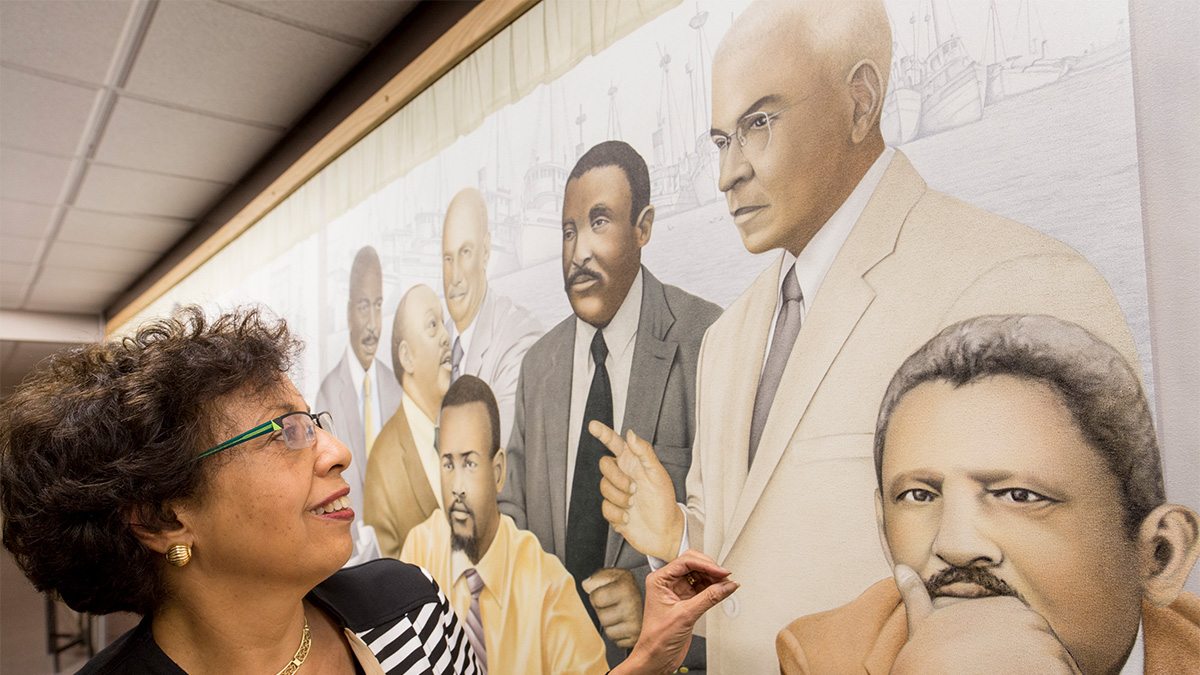‘SERVICE’ paints picture of Black history
The lunch counter mural in the School of Government serves up important people and events from the state’s past.

The UNC School of Government hosts over 12,000 public officials from local governments across North Carolina every year. During these visits, many of them make their way down to the Knapp-Sanders building dining hall. On their way, they pass by “SERVICE,” a eight-panel mural depicting notable figures and events from Black history in North Carolina.
The artist Colin Quashie framed the scene as a lunch counter and depicted as servers the Greensboro Four, whose 1960 sit-in at a segregated counter at F.W. Woolworth’s sparked similar protests in the Civil Rights Movement.
“They literally took possession of the lunch counter with their refusal to leave until served. By seeking service they were, by extension, serving a cause greater than themselves,” Quashie said. He intentionally chose the location in the building’s basement because its proximity to the dining hall would cause almost every public official visiting the school to engage with the mural.
According to Tom Thornburg, a retired faculty member and administrator, the school wanted to expand the reach of the building’s art collection. “We wanted to create art that would honor the history of African Americans and other minorities in North Carolina,” Thornburg said.
In 2008, after Knapp-Sanders underwent a renovation, the school commissioned “SERVICE.”
“We needed to display more works of art that reflect the School of Government’s mission to serve all local town and county governments in North Carolina, and all the people they represent,” said Ann Simpson, a former associate dean of development.
Simpson spearheaded the effort and led the creation of two committees: one to select the artist and one to consult the artist on North Carolina history. She recruited Thornburg and other School of Government faculty and staff, along with experts in the arts, to the artist selection committee, which awarded the commission to Quashie. The funding was sponsored by Local Government Federal Credit Union.
The history committee, comprising Carolina faculty members and historians from other state institutions, worked with Quashie to select figures and themes to feature in the mural. In addition to the Greensboro Four, the mural features prominent Black North Carolina historical figures such as Harvey Beech, the first Black student to graduate from Carolina’s law school; community organizer and journalist Ella Baker; and Pauli Murray, co-founder of the National Organization for Women.
The mural also includes references to historical places such as Princeville, the first town chartered by Black Americans, and Durham’s Parrish Street, the site of the prosperous “Black Wall Street” district in the early 20th century.
Joseph Jordan, a professor in African, African American and Diaspora studies who was then serving as director of the Stone Center for Black History and Culture, sat on the history committee and shared his expertise. He believes that North Carolina’s Black history needs to be better understood and viewed as a central element of the state’s history.
“We put up the mural because we want people to reflect their own experiences against what they’re seeing,” Jordan said. “And we want them also to understand that there are things beyond their own experience that may be useful for them to see.”
Quashie called it “sobering” to be entrusted with a project that held such significance.
“Being the oldest public university in America, UNC has a responsibility to embrace and showcase all of America’s history — a history that is inclusive of and not separate from Black history,” he said.
“Students and faculty of UNC should be proud caretakers of that legacy. Hopefully, this mural will continue to remind viewers that there is so much more that North Carolina history has to showcase to its students and residents.”
Explore and read more about “SERVICE” at servicemural.unc.edu







